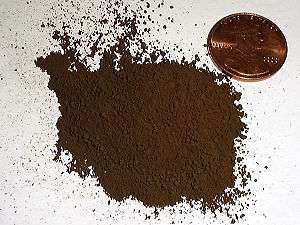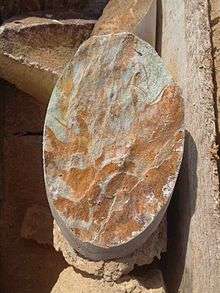Iron oxide
Iron oxides are chemical compounds composed of iron and oxygen. There are sixteen known iron oxides and oxyhydroxides, the best known of which is rust, a form of iron(III) oxide.[1]

Iron oxides and oxyhydroxides are widespread in nature and play an important role in many geological and biological processes. They are used as iron ores, pigments, catalysts, and in thermite, and occur in hemoglobin. Iron oxides are inexpensive and durable pigments in paints, coatings and colored concretes. Colors commonly available are in the "earthy" end of the yellow/orange/red/brown/black range. When used as a food coloring, it has E number E172.
Oxides


- Oxide of FeII
- FeO: iron(II) oxide, wüstite
- FeO2:[2] iron dioxide
- Mixed oxides of FeII and FeIII
- Oxide of FeIII
- Fe2O3: iron(III) oxide
- α-Fe2O3: alpha phase, hematite
- β-Fe2O3: beta phase
- γ-Fe2O3: gamma phase, maghemite
- ε-Fe2O3: epsilon phase
- Fe2O3: iron(III) oxide
Hydroxides
- iron(II) hydroxide (Fe(OH)2)
- iron(III) hydroxide (Fe(OH)3), (bernalite)
Oxide-hydroxides
- goethite (α-FeOOH),
- akaganéite (β-FeOOH),
- lepidocrocite (γ-FeOOH),
- feroxyhyte (δ-FeOOH),
- ferrihydrite ( approx.), or , better recast as
- high-pressure pyrite-structured FeOOH[8] . Once dehydration is triggered, this phase may form [9].
- schwertmannite (ideally or )[10]
- green rust ( where A− is Cl− or 0.5SO42−)
Microbial degradation
Several species of bacteria, including Shewanella oneidensis, Geobacter sulfurreducens and Geobacter metallireducens, metabolically utilize solid iron oxides as a terminal electron acceptor, reducing Fe(III) oxides to Fe(II) containing oxides.[11]
Environmental effects
Methanogenesis replacement by iron oxide reduction
Under conditions favoring iron reduction, the process of iron oxide reduction can replace at least 80% of methane production occurring by methanogenesis.[12] This phenomenon occurs in a nitrogen-containing (N2) environment with low sulfate concentrations. Methanogenesis, an Archaean driven process, is typically the predominate form of carbon mineralization in sediments at the bottom of the ocean. Methanogenesis completes the decomposition of organic matter to methane (CH4).[12] The specific electron donor for iron oxide reduction in this situation is still under debate, but the two potential candidates include either Titanium (III) or compounds present in yeast. The predicted reactions with Titanium (III) serving as the electron donor and phenazine-1-carboxylate (PCA) serving as an electron shuttle is as follows:
- Ti(III)-cit + CO2 + 8H+ → CH4 + 2H2O + Ti(IV) + cit ΔE = –240 + 300 mV
- Ti(III)-cit + PCA (oxidized) → PCA (reduced) + Ti(IV) + cit ΔE = –116 + 300 mV
- PCA (reduced) + Fe(OH)3 → Fe2+ + PCA (oxidized) ΔE = –50 + 116 mV [12]
- Note: cit = citrate.
Titanium (III) is oxidized to Titanium (IV) while PCA is reduced. The reduced form of PCA can then reduce the iron hydroxide (Fe(OH)3).
Hydroxyl radical formation
On the other hand when airborne, iron oxides have been shown to harm the lung tissues of living organisms by the formation of hydroxyl radicals, leading to the creation of alkyl radicals. The following reactions occur when Fe2O3 and FeO, hereafter represented as Fe3+ and Fe2+ respectively, iron oxide particulates accumulate in the lungs.[13]
The formation of the superoxide anion (O2• –) is catalyzed by a transmembrane enzyme called NADPH oxidase. The enzyme facilitates the transport of an electron across the plasma membrane from cytosolic NADPH to extracellular oxygen (O2) to produce O2• –. NADPH and FAD are bound to cytoplasmic binding sites on the enzyme. Two electrons from NADPH are transported to FAD which reduces it to FADH2. Then, one electron moves to one of two heme groups in the enzyme within the plane of the membrane. The second electron pushes the first electron to the second heme group so that it can associate with the first heme group. For the transfer to occur, the second heme must be bound to extracellular oxygen which is the acceptor of the electron. This enzyme can also be located within the membranes of intracellular organelles allowing the formation of O2• – to occur within organelles.[14]
The formation of hydrogen peroxide (H
2O
2) can occur spontaneously when the environment has a lower pH especially at pH 7.4.[15] The enzyme superoxide dismutase can also catalyze this reaction. Once H
2O
2 has been synthesized, it can diffuse through membranes to travel within and outside the cell due to its nonpolar nature.[14]
Fe2+ is oxidized to Fe3+ when it donates an electron to H2O2, thus, reducing H2O2 and forming a hydroxyl radical (HO•) in the process. H2O2 can then reduce Fe3+ to Fe2+ by donating an electron to it to create O2• –. O2• – can then be used to make more H2O2 by the process previously shown perpetuating the cycle, or it can react with H2O2 to form more hydroxyl radicals. Hydroxyl radicals have been shown to increase cellular oxidative stress and attack cell membranes as well as the cell genomes.[13]
- HO• + RH → R• + H2O [13]
The HO• radical produced from the above reactions with iron can abstract a hydrogen atom (H) from molecules containing an R-H bond where the R is a group attached to the rest of the molecule, in this case H, at a carbon (C).[13]
See also
References
- Cornell., RM.; Schwertmann, U (2003). The iron oxides: structure, properties, reactions, occurrences and. Wiley VCH. ISBN 978-3-527-30274-1.
- Hu, Qingyang; Kim, Duck Young; Yang, Wenge; Yang, Liuxiang; Meng, Yue; Zhang, Li; Mao, Ho-Kwang (June 2016). "FeO2 and (FeO)OH under deep lower-mantle conditions and Earth's oxygen–hydrogen cycles". Nature. 534 (7606): 241–244. Bibcode:2016Natur.534..241H. doi:10.1038/nature18018. ISSN 1476-4687. PMID 27279220.
- Lavina, B.; Dera, P.; Kim, E.; Meng, Y.; Downs, R. T.; Weck, P. F.; Sutton, S. R.; Zhao, Y. (Oct 2011). "Discovery of the recoverable high-pressure iron oxide Fe4O5". Proceedings of the National Academy of Sciences. 108 (42): 17281–17285. Bibcode:2011PNAS..10817281L. doi:10.1073/pnas.1107573108. PMC 3198347. PMID 21969537.
- Lavina, Barbara; Meng, Yue (2015). "Synthesis of Fe5O6". Science Advances. 1 (5): e1400260. doi:10.1126/sciadv.1400260. PMC 4640612. PMID 26601196.
- Bykova, E.; Dubrovinsky, L.; Dubrovinskaia, N.; Bykov, M.; McCammon, C.; Ovsyannikov, S. V.; Liermann, H. -P.; Kupenko, I.; Chumakov, A. I.; Rüffer, R.; Hanfland, M.; Prakapenka, V. (2016). "Structural complexity of simple Fe2O3 at high pressures and temperatures". Nature Communications. 7: 10661. doi:10.1038/ncomms10661. PMC 4753252. PMID 26864300.
- Merlini, Marco; Hanfland, Michael; Salamat, Ashkan; Petitgirard, Sylvain; Müller, Harald (2015). "The crystal structures of Mg2Fe2C4O13, with tetrahedrally coordinated carbon, and Fe13O19, synthesized at deep mantle conditions". American Mineralogist. 100 (8–9): 2001–2004. doi:10.2138/am-2015-5369.
- Fakouri Hasanabadi, M.; Kokabi, A.H.; Nemati, A.; Zinatlou Ajabshir, S. (February 2017). "Interactions near the triple-phase boundaries metal/glass/air in planar solid oxide fuel cells". International Journal of Hydrogen Energy. 42 (8): 5306–5314. doi:10.1016/j.ijhydene.2017.01.065. ISSN 0360-3199.
- Nishi, Masayuki; Kuwayama, Yasuhiro; Tsuchiya, Jun; Tsuchiya, Taku (2017). "The pyrite-type high-pressure form of FeOOH". Nature. 547 (7662): 205–208. doi:10.1038/nature22823. ISSN 1476-4687.
- Hu, Qingyang; Kim, Duckyoung; Liu, Jin; Meng, Yue; Liuxiang, Yang; Zhang, Dongzhou; Mao, Wendy L.; Mao, Ho-kwang (2017). "Dehydrogenation of goethite in Earth's deep lower mantle". Proceedings of the National Academy of Sciences. 114 (7): 1498–1501. doi:10.1073/pnas.1620644114.
- http://www.mindat.org/min-7281.html Mindat
- Bretschger, O.; Obraztsova, A.; Sturm, C. A.; Chang, I. S.; Gorby, Y. A.; Reed, S. B.; Culley, D. E.; Reardon, C. L.; Barua, S.; Romine, M. F.; Zhou, J.; Beliaev, A. S.; Bouhenni, R.; Saffarini, D.; Mansfeld, F.; Kim, B.-H.; Fredrickson, J. K.; Nealson, K. H. (20 July 2007). "Current Production and Metal Oxide Reduction by Shewanella oneidensis MR-1 Wild Type and Mutants". Applied and Environmental Microbiology. 73 (21): 7003–7012. doi:10.1128/AEM.01087-07. PMC 2223255. PMID 17644630.
- Sivan, O.; Shusta, S. S.; Valentine, D. L. (2016-03-01). "Methanogens rapidly transition from methane production to iron reduction". Geobiology. 14 (2): 190–203. doi:10.1111/gbi.12172. ISSN 1472-4669. PMID 26762691.
- Hartwig, A.; MAK Commission 2016 (July 25, 2016). Iron oxides (inhalable fraction) [MAK Value Documentation, 2011]. The MAK Collection for Occupational Health and Safety. 1. pp. 1804–1869. doi:10.1002/3527600418.mb0209fste5116. ISBN 9783527600410.
- Bedard, Karen; Krause, Karl-Heinz (2007-01-01). "The NOX Family of ROS-Generating NADPH Oxidases: Physiology and Pathophysiology". Physiological Reviews. 87 (1): 245–313. doi:10.1152/physrev.00044.2005. ISSN 0031-9333. PMID 17237347.
- Chapple, Iain L. C.; Matthews, John B. (2007-02-01). "The role of reactive oxygen and antioxidant species in periodontal tissue destruction". Periodontology 2000. 43 (1): 160–232. doi:10.1111/j.1600-0757.2006.00178.x. ISSN 1600-0757. PMID 17214840.
External links
| Wikimedia Commons has media related to Iron oxides. |